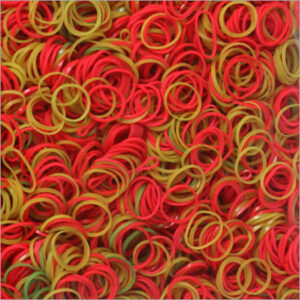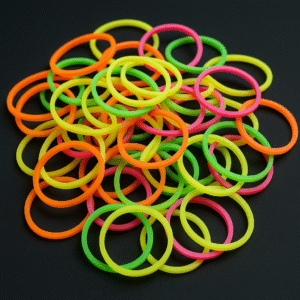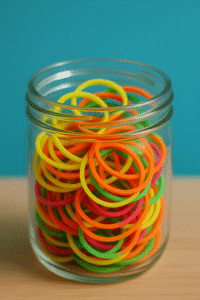Why Our Rubber Bands Don’t Easily Snap: The Science of Snap Resistance
The single most important and non-negotiable quality of a rubber band is its ability to not break under tension. A band that snaps easily is more than just a frustration; it’s a failure of its core purpose. In a professional setting, this failure can lead to damaged products, lost time, and even safety hazards. The exceptional snap resistance of a RuBands product is not a matter of luck; it is the direct and deliberate result of a deep commitment to quality that is woven into every stage of our process. It is a product of superior materials, a scientific approach to our compound, and a world-class quality manufacturing process.
So, why do our bands have a superior level of durability and strength compared to low-cost alternatives? The answer lies in a holistic engineering philosophy that is designed to combat the primary causes of rubber band failure from the very beginning. This article will explore the science behind why our bands are so resistant to snapping, giving you a behind-the-scenes look at the choices we make to build a more reliable product.
The Root Cause of Failure: The “Weakest Link” Principle
Before we explore the solutions, we must understand the problem. A rubber band almost never fails because the entire band gives way at once. It fails because of the “weakest link” principle. A failure almost always starts at a single, microscopic flaw—a tiny nick, a particle of impurity, or a poorly formed molecular bond. This flaw becomes a “stress concentration point.” When the band is stretched, the tension becomes highly concentrated at the tip of this flaw, causing a micro-tear to start. Once started, this tear can “unzip” across the band in an instant, leading to a catastrophic snap. Therefore, the secret to superior snap resistance is a manufacturing process that is obsessed with eliminating these potential weak links.
1. It Starts with a Superior Molecular Foundation
Our commitment to strength begins with the raw material itself. We build our bands on a stronger molecular foundation.
- The Power of Long-Chain Polymers: We source only high-grade natural rubber, which is characterized by its very long polymer chains. These long chains create a dense and highly entangled molecular network. This network has a much higher “tear energy,” which is the energy required to create and propagate a tear. To snap a band made of long-chain polymers, you have to physically break or pull apart these long, tangled chains, which requires a great deal of force. A low-quality rubber made from shorter chains has a much less robust network and will fail much more easily.
– A Commitment to Purity: We rigorously test our raw materials to ensure they are free from the impurities (like dirt or bark particles) that can be found in lower-grade rubber. Each of these tiny impurities is a potential stress concentration point, a built-in weak link. By starting with a cleaner, purer material, we eliminate these flaws from the very beginning.
2. The Perfect Cure: The Art and Science of Vulcanization
The vulcanization process, where the rubber is cured with heat to create cross-links between the polymer chains, is the most critical step in creating a band’s strength and durability.
- Optimized Cross-Link Density: The strength of the final product is determined by the density of these cross-links. Our R&D team has spent years perfecting our formulas and our curing cycles to achieve the “goldilocks” density of cross-links—enough to create a powerful and robust molecular network that resists tearing, but not so many that the band becomes hard and brittle.
– The Importance of a Uniform Cure: This is a key part of our quality manufacturing process. Our state-of-the-art, computer-controlled vulcanization autoclaves ensure that every single part of a batch receives the exact same, optimal cure. A competitor using older, less precise equipment can produce a product with an uneven cure, resulting in a band with a mix of weak, under-cured spots and brittle, over-cured spots. Our process ensures a uniform and consistently strong molecular structure throughout the entire band.
3. The Flawless Finish: Precision in Extrusion and Cutting
Many failures begin with a surface-level imperfection. Our process is designed to create a flawless finish.
- Smooth Extrusion: Our laser-micrometer-guided extrusion lines produce a rubber tube with a perfectly smooth, uniform surface, free from the striations or flaws that could become the starting point for a tear.
– The Cleanest Cut: The final cut that slices the tube into individual bands is a critical and often overlooked detail. We use ultra-sharp, precision-aligned tungsten carbide blades. This ensures a clean, perpendicular cut with a smooth edge. A dull blade can drag or tear the rubber, creating a rough, jagged edge that is filled with microscopic nicks—a perfect breeding ground for a future failure. A clean cut is a strong cut.
4. The Final Proof: Relentless Testing
We don’t just assume our bands are strong; we prove it. Our quality assurance team tests samples from every single production batch on our tensile testing machines. We stretch them to their breaking point to get a hard, data-driven measurement of their ultimate tensile strength. This relentless testing is our final guarantee that every band that leaves our factory meets our high standards for snap resistance.
Conclusion: Strength by Design
The reason why RuBands products don’t easily snap is not a single secret; it is a holistic philosophy of excellence. It is a commitment that begins with the selection of a superior raw material, is enhanced by a scientifically optimized compound, is executed through a precision quality manufacturing process, and is verified by rigorous, data-driven testing. The superior strength and durability you feel in our product is a direct result of this comprehensive commitment to eliminating the weak links and building a stronger, more reliable product from the molecule up.






